Introduction:
Homs or Hims is the third important city in Syria and it is strategically located at the fertile Orontes River (Naher al-Aassi, - Assi means Rebel, since the river runs northwards) Valley in the centre of Syria, between Damascus (162 Km South) and Aleppo (193 Km north). It is very close to the coast (Tartus, 96 Km West) and is not far from Hama (47 Km) to the north and Palmyra (155 Km) to the southeast. Homs is the only natural gateway from the Mediterranean coast to the interior.
History
Homs is an ancient city dating back to the year 2300 B.C and was known in Roman times as Emesa, which contained a great temple to the sun god El Gebal (Aramaic; Latin: Elagabalus; Greek: Heliogabalus). Emesa was ruled by a line of priest-kings throughout the Roman Empire, and two of its nobility rose to become emperor, Elagabalus and Severus Alexande who ruled Rome from 193 to 211. Four Homs women became Roman Empresses -Julia Domma, Julia Maesa, Julia Mammea and Julia Soemia. Aurelian (reigned AD 270-275) made the town his headquarters and there defeated Queen Zenobia of Palmyra. Emesa's fortunes were always tied with the trade city of Palmyra. As long as Palmyra flourished so did Emesa. When Zenobia was defeated at Palmyra in about 272 AD, Emesa declined. Only the remains of one citadel built above a rocky hill south of the city with two gates and a wall remained intact. The two gates are: Bab Sham (Damascus) and the Bab Palmyra. Homs wasthe third station on the Silk Road after Doura Europos and Palmyra.
Christianity was established in Emesa early on, as 3rd to 7th century. Catacombs were found in houses in the eastern quarter, where quite a large population of Christians still live. After Arab conquest, it is said that 500 of the prophet's companions came and settled here. Homs became important, again but by the 18th century Homs had sunk into a state of weakness.
Homs was taken in 636 by the Muslims, who renamed it Homs, and the city's large Christian element was eliminated during the rebellion of 855. Hims later (1516) passed into Ottoman hands, where it remained, except for a brief period of Egyptian control in the 1830s, until the creation of Syria after World War I.
The word " Homs " derives from a Canaanite root that means shyness.
Attractions and historical building
The prime attractions and most important historical building in the city of Homs are:
- The Khaled Ibn Al-Walid Mosque (take the name of the Arab Moslim leader Khaled Bin Al-Walid who lived in Homs for the last seven years of his life), this building is distinguished by its metal dome which reflects sunshine. It is also famous for its two high minarets and narrow galleries built with black and white stones in a horizontal manner. The shrine and mosque erected in 1908 honours the Arab general and conqueror Khaled ibn al-Walid, known as "the Sword of Islam," who died there in 642.
- The Kaneesat Um Zunnar Church which was named after a piece of cloth said to have belonged to the Virgin Mary that was found underneath the alter during renovations in the 1950's.
- Another church in the area is Kaneesat Mar Elian Church which also had discovered beautiful wall paintings and mosaic in the 1970's during renovations. It also contains Arab and Greek scripts dating back to the twelfth century AD and even as far back as the sixth century.
- The ruins of the underground monastery and chapel of the Syrian Aramain Church.
- Other attractions include the Citadel,Homs Old gates, Al Nouri Mosque (or Great Mosque), the ancient souks. Hims also contains a medieval citadel with remains of older foundations.
- Between Homs and Tartus, the Krak Des Chevaliers (Qalaat al-Hossn) is the most important castle of the middle ages. It is located 65 km west of Homs and reaches a summit of 750 meters above sea level. The castle controls a strategic passage called the Homs gap in the Orontes Valley. The castle was erected covers an area of 3 hectares and has 13 towers containing a number of halls, stores, passages, stables and bridges.
- The Qattina Lake which is 15 kilometers from Homs; it has rainwater dam used in agriculture. Which dates back to the 2nd millennium B.C. Close to this lake is the archaeological hill called Tal al-Nabi Mando (Qadesh), where a historic battle took place between the Hittites and the Egyptians in the thirteenth century B.C
- In the Homs museum, there are many archaeological artifacts dating back to the ancient Syrian, Greek, Roman, Byzantine and Arab eras.
- Other places of interest around Homs, include al-Rastan, Meshta al-Helu (Resort Town), Mar Jourjous (Monastery of St. George), Wadi al-Nasara (collection of Christian villages surrounding Qalaat al-Hosn), al-Mishrefeh and Lake Qattina.
- Homs has a very beatiful Restaurants on Orontes river-side like, Dik al Jen, Abbara, Al Ahram, Marsella, Miranda, Abu Samra, Al Dawwar, Kardinia and al Tannur.
Economy
Homs governorate is the largest in Syria (43,630 sq.km.). Its central location and size made it the third governorate in agriculture, trade and industry.
Homs is distinguished from other Syrian governorates in its important strategic location. It is in the middle of Syria, on a hill of approximately 508m height above sea level.
Homs is situated in a fertile agricultural region that produces wheat, corn (maize), millet, cotton, fruits, and vegetables. The city has thus become a thriving agricultural market centre; its local handicrafts, which include jewelry, belts, and cloaks, are also well-known. In addition, Hims has an oil refinery opened in 1959, an agricultural research station, fertilizer and vegetable-oil plants, a sugar refinery, and a university (1979). The hub of an important road and rail network, it is the central link between the interior cities and the Mediterranean coast.
............................
Unfortunately, ancient earthquakes destroyed many buildings and citadels in Homs. There remains only one citadel in the south of the city with its Damascus and Palmyra gates.
 This historical city produced many impressive personalities. Bassianos (an emir of Homs), through his daughter's marriage to the Roman emperor, Septimium Severus, who ruled Rome from 193 to 211 AD, sired three rulers, Caracalla, Heliogabalus and Alexander Severus. The city was the birthplace of the famous Syrian philosopher, Longenius, counselor to Queen Zenobia, and of the famous physician, Marlian.
This historical city produced many impressive personalities. Bassianos (an emir of Homs), through his daughter's marriage to the Roman emperor, Septimium Severus, who ruled Rome from 193 to 211 AD, sired three rulers, Caracalla, Heliogabalus and Alexander Severus. The city was the birthplace of the famous Syrian philosopher, Longenius, counselor to Queen Zenobia, and of the famous physician, Marlian.
Among the most significant historic constructions remaining in Homs is the mosque of Khalid ibn Al-Walid, the great commander of the Muslim Arab armies. Two very tall white-stone minarets lend lightness to the imposing structure. The slender colonnade in black and white stone in horizontal rows is representative of traditional Syrian architecture.
Many churches still stand in Homs from the days of early Christianity in Syria. One of these churches is said to possess the girdle of the Blessed Virgin. The church of St. Elian is unique for its collection of fine frescoes discovered in 1970. These bear inscriptions in Greek and Arabic, and date back to the end of the 12th century.
The Nuri mosque also dates back to the 12th century, distinguished for its beautiful entrance.
In Homs museum, there are many archaeological artifacts dating back to the ancient Syrian, Greek, Roman, Byzantine and Arab eras.
The Qattina lake is 15 km from Homs, it is rich in fish, and has the first rainwater dam used in agriculture which dates back to the 2nd millennium BC. Close to this lake is the archaeological hill called Tel Ennabi Mand (Qadesh), where a historic battle took place between the Hittites and the Egyptians in the 13th century BC.

 Old Churches:
Old Churches:
- Church of al Zunnar (the church of the Virgin's belt):
the curious name derives from the discovery under the church's altar in 1953 of a textile belt said to have belonged to the Virgin. The belt is believed to have been placed in the first church on this spot in the late forth century. Most of the present church's structure dates from the last 100 years.
Church of St Elian:
it is more interesting the frescoes found in this church. Church of St Elian is dedicated to the son of a Roman officer from Emesa martyred at the end of the third century for refusing to renounce Christianity. The martyrium at the end of right hand nave is the burial place of St Elian and other saints and houses a remarkable set of mural paintings of the 12th century and earlier which were discovered in 1970. The church is still a pilgrimage center due to the miracles associated with St Elian and its renewed fame has resulted in an expansion and redecoration of the main nave. The modern painted frescoes are devoted to the life of St Elian.
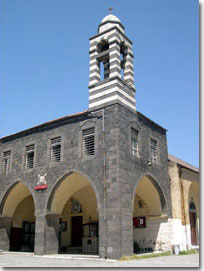
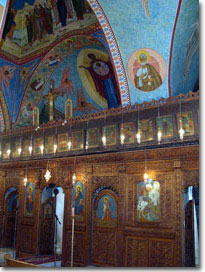
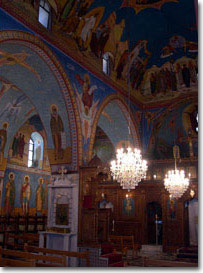
Walls:
The walls of the city and its seven gates were largely demolished in the ottoman period. Remains of two of the gates survive in Bab al Masdud (Closed Gate) in the west and Bab Tadmor (Palmyra Gate) to the north east. Only a few glimpses of the old walls survive. The remains of the citadel of Homs can be seen on the mound which marks the south west corner of the old city.
Mosque of Khaled Ibn al Walid:
The mosque, completely rebuilt in the late Turkish period (1908 - 13), is on a site dating back to Ayyūbid times and contains the reputed tomb of one of the early followers of Muhammed, Khaled Ibn al Walid, whose military campaigns in Syria led to the Islamic conquest. He died in 642; his exploits have been eclipsed by his sworn enemy, the Caliph Umar.
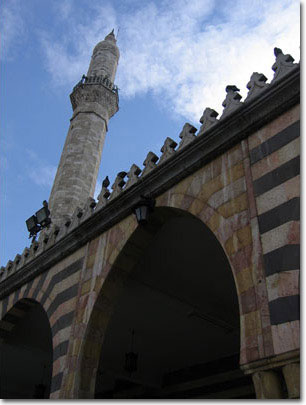
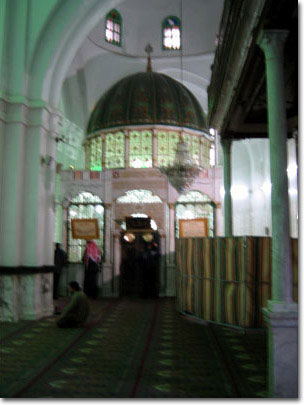

Homs or Hims is the third important city in Syria and it is strategically located at the fertile Orontes River (Naher al-Aassi, - Assi means Rebel, since the river runs northwards) Valley in the centre of Syria, between Damascus (162 Km South) and Aleppo (193 Km north). It is very close to the coast (Tartus, 96 Km West) and is not far from Hama (47 Km) to the north and Palmyra (155 Km) to the southeast. Homs is the only natural gateway from the Mediterranean coast to the interior.
History
Homs is an ancient city dating back to the year 2300 B.C and was known in Roman times as Emesa, which contained a great temple to the sun god El Gebal (Aramaic; Latin: Elagabalus; Greek: Heliogabalus). Emesa was ruled by a line of priest-kings throughout the Roman Empire, and two of its nobility rose to become emperor, Elagabalus and Severus Alexande who ruled Rome from 193 to 211. Four Homs women became Roman Empresses -Julia Domma, Julia Maesa, Julia Mammea and Julia Soemia. Aurelian (reigned AD 270-275) made the town his headquarters and there defeated Queen Zenobia of Palmyra. Emesa's fortunes were always tied with the trade city of Palmyra. As long as Palmyra flourished so did Emesa. When Zenobia was defeated at Palmyra in about 272 AD, Emesa declined. Only the remains of one citadel built above a rocky hill south of the city with two gates and a wall remained intact. The two gates are: Bab Sham (Damascus) and the Bab Palmyra. Homs wasthe third station on the Silk Road after Doura Europos and Palmyra.
Christianity was established in Emesa early on, as 3rd to 7th century. Catacombs were found in houses in the eastern quarter, where quite a large population of Christians still live. After Arab conquest, it is said that 500 of the prophet's companions came and settled here. Homs became important, again but by the 18th century Homs had sunk into a state of weakness.
Homs was taken in 636 by the Muslims, who renamed it Homs, and the city's large Christian element was eliminated during the rebellion of 855. Hims later (1516) passed into Ottoman hands, where it remained, except for a brief period of Egyptian control in the 1830s, until the creation of Syria after World War I.
The word " Homs " derives from a Canaanite root that means shyness.
Attractions and historical building
The prime attractions and most important historical building in the city of Homs are:
- The Khaled Ibn Al-Walid Mosque (take the name of the Arab Moslim leader Khaled Bin Al-Walid who lived in Homs for the last seven years of his life), this building is distinguished by its metal dome which reflects sunshine. It is also famous for its two high minarets and narrow galleries built with black and white stones in a horizontal manner. The shrine and mosque erected in 1908 honours the Arab general and conqueror Khaled ibn al-Walid, known as "the Sword of Islam," who died there in 642.
- The Kaneesat Um Zunnar Church which was named after a piece of cloth said to have belonged to the Virgin Mary that was found underneath the alter during renovations in the 1950's.
- Another church in the area is Kaneesat Mar Elian Church which also had discovered beautiful wall paintings and mosaic in the 1970's during renovations. It also contains Arab and Greek scripts dating back to the twelfth century AD and even as far back as the sixth century.
- The ruins of the underground monastery and chapel of the Syrian Aramain Church.
- Other attractions include the Citadel,Homs Old gates, Al Nouri Mosque (or Great Mosque), the ancient souks. Hims also contains a medieval citadel with remains of older foundations.
- Between Homs and Tartus, the Krak Des Chevaliers (Qalaat al-Hossn) is the most important castle of the middle ages. It is located 65 km west of Homs and reaches a summit of 750 meters above sea level. The castle controls a strategic passage called the Homs gap in the Orontes Valley. The castle was erected covers an area of 3 hectares and has 13 towers containing a number of halls, stores, passages, stables and bridges.
- The Qattina Lake which is 15 kilometers from Homs; it has rainwater dam used in agriculture. Which dates back to the 2nd millennium B.C. Close to this lake is the archaeological hill called Tal al-Nabi Mando (Qadesh), where a historic battle took place between the Hittites and the Egyptians in the thirteenth century B.C
- In the Homs museum, there are many archaeological artifacts dating back to the ancient Syrian, Greek, Roman, Byzantine and Arab eras.
- Other places of interest around Homs, include al-Rastan, Meshta al-Helu (Resort Town), Mar Jourjous (Monastery of St. George), Wadi al-Nasara (collection of Christian villages surrounding Qalaat al-Hosn), al-Mishrefeh and Lake Qattina.
- Homs has a very beatiful Restaurants on Orontes river-side like, Dik al Jen, Abbara, Al Ahram, Marsella, Miranda, Abu Samra, Al Dawwar, Kardinia and al Tannur.
Economy
Homs governorate is the largest in Syria (43,630 sq.km.). Its central location and size made it the third governorate in agriculture, trade and industry.
Homs is distinguished from other Syrian governorates in its important strategic location. It is in the middle of Syria, on a hill of approximately 508m height above sea level.
Homs is situated in a fertile agricultural region that produces wheat, corn (maize), millet, cotton, fruits, and vegetables. The city has thus become a thriving agricultural market centre; its local handicrafts, which include jewelry, belts, and cloaks, are also well-known. In addition, Hims has an oil refinery opened in 1959, an agricultural research station, fertilizer and vegetable-oil plants, a sugar refinery, and a university (1979). The hub of an important road and rail network, it is the central link between the interior cities and the Mediterranean coast.
............................
Homs, Syria
Unfortunately, ancient earthquakes destroyed many buildings and citadels in Homs. There remains only one citadel in the south of the city with its Damascus and Palmyra gates.
 This historical city produced many impressive personalities. Bassianos (an emir of Homs), through his daughter's marriage to the Roman emperor, Septimium Severus, who ruled Rome from 193 to 211 AD, sired three rulers, Caracalla, Heliogabalus and Alexander Severus. The city was the birthplace of the famous Syrian philosopher, Longenius, counselor to Queen Zenobia, and of the famous physician, Marlian.
This historical city produced many impressive personalities. Bassianos (an emir of Homs), through his daughter's marriage to the Roman emperor, Septimium Severus, who ruled Rome from 193 to 211 AD, sired three rulers, Caracalla, Heliogabalus and Alexander Severus. The city was the birthplace of the famous Syrian philosopher, Longenius, counselor to Queen Zenobia, and of the famous physician, Marlian.Among the most significant historic constructions remaining in Homs is the mosque of Khalid ibn Al-Walid, the great commander of the Muslim Arab armies. Two very tall white-stone minarets lend lightness to the imposing structure. The slender colonnade in black and white stone in horizontal rows is representative of traditional Syrian architecture.
Many churches still stand in Homs from the days of early Christianity in Syria. One of these churches is said to possess the girdle of the Blessed Virgin. The church of St. Elian is unique for its collection of fine frescoes discovered in 1970. These bear inscriptions in Greek and Arabic, and date back to the end of the 12th century.
The Nuri mosque also dates back to the 12th century, distinguished for its beautiful entrance.
In Homs museum, there are many archaeological artifacts dating back to the ancient Syrian, Greek, Roman, Byzantine and Arab eras.
The Qattina lake is 15 km from Homs, it is rich in fish, and has the first rainwater dam used in agriculture which dates back to the 2nd millennium BC. Close to this lake is the archaeological hill called Tel Ennabi Mand (Qadesh), where a historic battle took place between the Hittites and the Egyptians in the 13th century BC.
- Church of al Zunnar (the church of the Virgin's belt):
the curious name derives from the discovery under the church's altar in 1953 of a textile belt said to have belonged to the Virgin. The belt is believed to have been placed in the first church on this spot in the late forth century. Most of the present church's structure dates from the last 100 years.
Church of St Elian:
it is more interesting the frescoes found in this church. Church of St Elian is dedicated to the son of a Roman officer from Emesa martyred at the end of the third century for refusing to renounce Christianity. The martyrium at the end of right hand nave is the burial place of St Elian and other saints and houses a remarkable set of mural paintings of the 12th century and earlier which were discovered in 1970. The church is still a pilgrimage center due to the miracles associated with St Elian and its renewed fame has resulted in an expansion and redecoration of the main nave. The modern painted frescoes are devoted to the life of St Elian.



Walls:
The walls of the city and its seven gates were largely demolished in the ottoman period. Remains of two of the gates survive in Bab al Masdud (Closed Gate) in the west and Bab Tadmor (Palmyra Gate) to the north east. Only a few glimpses of the old walls survive. The remains of the citadel of Homs can be seen on the mound which marks the south west corner of the old city.
Mosque of Khaled Ibn al Walid:
The mosque, completely rebuilt in the late Turkish period (1908 - 13), is on a site dating back to Ayyūbid times and contains the reputed tomb of one of the early followers of Muhammed, Khaled Ibn al Walid, whose military campaigns in Syria led to the Islamic conquest. He died in 642; his exploits have been eclipsed by his sworn enemy, the Caliph Umar.


No comments:
Post a Comment